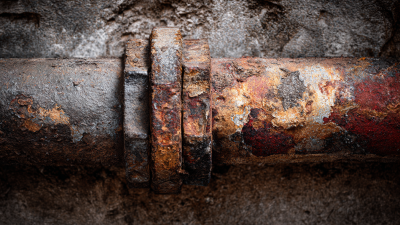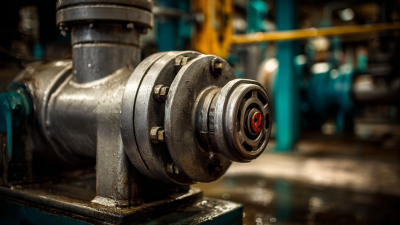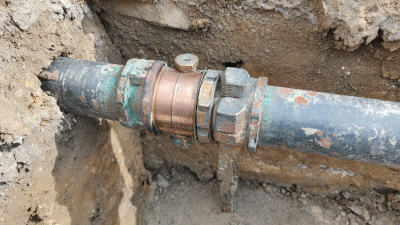Exploring the Future of Pipe Rehabilitation: Innovations and Best Practices for Sustainable Infrastructure
As urban infrastructure continues to age and face increasing demands, the need for effective pipe rehabilitation has become more crucial than ever. This article delves into the future of pipe rehabilitation by exploring innovative approaches and best practices that promote sustainability within infrastructure development. As cities grapple with the twin challenges of deteriorating pipelines and environmental responsibility, advancements in technology and materials offer promising solutions.

From trenchless technologies to the integration of smart sensors for monitoring structural integrity, these innovations not only enhance the efficiency and longevity of water and sewage systems but also minimize ecological impact. This exploration highlights the importance of adopting a forward-thinking mindset in the realm of pipe rehabilitation, ensuring that infrastructure can adapt to modern needs while considering the sustainability of our natural resources.
Through this examination, we aim to illuminate the path forward in creating resilient, eco-friendly urban environments that prioritize the health of both the communities they serve and the ecosystems they inhabit.
Innovative Materials and Technologies Transforming Pipe Rehabilitation Practices
Innovative materials and technologies are reshaping the landscape of pipe rehabilitation practices, offering sustainable solutions to aging water infrastructure. With millions of miles of obsolete pipelines posing severe risks of failure, the industry is increasingly adopting new materials that enhance durability and reduce leakage. These advancements are critical as the construction sector looks for efficient ways to address infrastructure challenges while minimizing environmental impact.
One notable innovation is the use of recycled materials in pipe rehabilitation. Just as the fashion industry is striving to become more sustainable through recyclable technologies, the pipe market is also embracing similar principles. Utilizing materials that can be repurposed not only lowers costs but also contributes to a circular economy, significantly reducing the carbon footprint associated with new material production.
**Tips for Implementing Innovative Rehabilitation Practices:**
1. **Explore Alternative Materials:** Investigate options like composite pipes that combine strength and flexibility, which can improve longevity and reduce maintenance needs.
2. **Incorporate Cutting-Edge Technologies:** Use diagnostic tools such as smart sensors to monitor pipeline conditions in real-time, helping to proactively manage potential failures.
3. **Engage in Collaborative Partnerships:** Work with technology providers and material scientists to stay at the forefront of developments in sustainable materials, ensuring that your practices evolve alongside industry innovations.
The Role of Smart Infrastructure in Enhancing Pipe Rehabilitation Efficiency
As urban infrastructure faces increasing pressure from aging systems and growing populations, the integration of smart technology in pipe rehabilitation emerges as a crucial innovation. Smart infrastructure enables real-time monitoring and data analytics, significantly enhancing the efficiency of rehabilitation projects. According to a report by the American Society of Civil Engineers (ASCE), it is estimated that investing in smart technology can reduce infrastructure maintenance costs by 20-30%, contributing to a more sustainable approach in managing pipe systems.
Using Internet of Things (IoT) devices, utilities can gather extensive data on pipe conditions, flow rates, and potential leaks. This proactive approach not only extends the lifespan of piping systems but also minimizes the environmental impact usually associated with traditional rehabilitation methods. A study conducted by the Water Research Foundation found that implementing smart sensors in pipe networks has the potential to decrease water loss by 25%, showcasing a strong case for investing in smart infrastructure. By leveraging these innovative practices, municipalities can ensure more resilient and efficient management of their water systems.
Sustainable Approaches to Urban Pipe Management for Climate Resilience
Urban pipe management is increasingly critical in the face of climate change, with cities facing the dual challenge of aging infrastructure and extreme weather events. According to the American Society of Civil Engineers (ASCE), approximately 6 billion gallons of treated water are lost daily due to leaky pipes, highlighting the urgent need for sustainable rehabilitation methods to enhance the resilience of our infrastructure. Innovative technologies such as trenchless technology and smart pipe monitoring are emerging as effective solutions, enabling municipalities to repair and maintain pipelines without extensive excavation, thereby minimizing disruption and environmental impact.
Sustainable approaches to urban pipe management not only address the urgent need for repairs but also support climate resilience. A recent report by the Water Research Foundation emphasizes that the integration of green infrastructure techniques, such as bioretention systems and permeable pavements, can significantly reduce stormwater runoff, thereby alleviating stress on urban drainage systems. By adopting a holistic view that combines traditional pipe rehabilitation with advanced monitoring systems and sustainable practices, cities can create adaptive networks that not only withstand but thrive in the changing climate, ensuring safe and reliable water services for their communities.
Exploring the Future of Pipe Rehabilitation: Innovations and Best Practices for Sustainable Infrastructure
| Dimension | Description | Current Practices | Innovations | Sustainability Impact |
|---|---|---|---|---|
| Pipe Materials | Types of materials used for pipes. | PVC, HDPE, and Concrete Pipes. | Recycled plastic pipes and bio-based materials. | Reduction in carbon footprint and resource conservation. |
| Inspection Technologies | Techniques to assess pipe condition. | CCTV and sonar inspection. | AI-enabled predictive analysis and drones. | Early detection of issues, leading to less invasive repairs. |
| Repair Techniques | Methods for rehabilitating old pipes. | Slip lining and patch repair. | Trenchless technologies and in-situ pipe relining. | Less environmental disruption and reduced waste. |
| Monitoring Systems | Systems to continuously assess pipe health. | Manual inspections and periodic monitoring. | Smart sensors and IoT integration. | Improved asset management and reduced emergency repairs. |
Best Practices for Implementing Robotic Solutions in Pipe Inspection and Repair
As the demand for efficient and sustainable infrastructure solutions grows, the implementation of robotic technologies in pipe inspection and repair is becoming increasingly vital. According to a report by Research and Markets, the global market for robotic systems in pipeline inspection is projected to reach $3.2 billion by 2026, reflecting a compound annual growth rate of approximately 15%. This surge is driven by the need for cost-effective maintenance methods that minimize downtime and enhance operational safety.
Robotic solutions offer several advantages over traditional inspection methods. First, they can navigate complex and challenging environments, such as urban sewer systems or industrial pipelines, with precision and minimal disturbance. For example, the use of remote-controlled drones equipped with cameras and sensors allows for real-time data collection, reducing the need for labor-intensive manual inspections. Moreover, integrating artificial intelligence into these robotic systems enables predictive maintenance, which can significantly extend the lifespan of infrastructure by addressing potential issues before they escalate.
Best practices for implementing robotic solutions involve ensuring adequate training for operators and developing robust data analysis frameworks. Stakeholders should prioritize collaboration among technology providers, municipal agencies, and engineers to create standardized protocols that maximize the effectiveness of robotic interventions. By leveraging innovations in robotic technology, the industry can move towards a more sustainable and resilient future for pipeline maintenance and rehabilitation.

Evaluating the Economic Impact of Preventive Maintenance on Aging Pipe Systems
 As aging pipe systems continue to pose significant challenges for urban infrastructure, the economic impact of preventive maintenance becomes increasingly vital. By investing in regular inspections and maintenance, municipalities can mitigate the risks of catastrophic failures, which can incur exorbitant repair costs and service disruptions. Preventive maintenance not only extends the lifespan of these systems but also optimizes resource allocation, ultimately enhancing overall efficiency and sustainability.
As aging pipe systems continue to pose significant challenges for urban infrastructure, the economic impact of preventive maintenance becomes increasingly vital. By investing in regular inspections and maintenance, municipalities can mitigate the risks of catastrophic failures, which can incur exorbitant repair costs and service disruptions. Preventive maintenance not only extends the lifespan of these systems but also optimizes resource allocation, ultimately enhancing overall efficiency and sustainability.
Tips for Successful Preventive Maintenance:
- Implement a proactive inspection routine using advanced technologies such as drones and acoustic sensors to identify weaknesses before they escalate.
- Develop a comprehensive asset management plan that prioritizes the rehabilitation of critical infrastructure based on risk assessments and life-cycle analysis.
In addition to financial savings, preventive maintenance promotes environmental sustainability by reducing waste and minimizing the need for new materials. By fostering a culture of regular upkeep and innovation, cities can create resilient infrastructures capable of meeting future demands while also granting peace of mind to their communities.
Related Posts
-

Revolutionizing Home Maintenance: The Scientific Benefits of Digless Pipe Repair Techniques
-

How to Identify Common Symptoms of Pump Issues Before Calling for Repair
-

Why No Dig Pipe Repair is the Future of Sustainable Plumbing Solutions
-

Comprehensive Pump Repair Checklist for Efficient Plant Operations and Reduced Downtime
-

7 Essential Tips for Effective Home Sewer Line Repair You Can't Ignore
-

How to Effectively Utilize Pipe in Pipe Repair Techniques for Long-lasting Solutions

